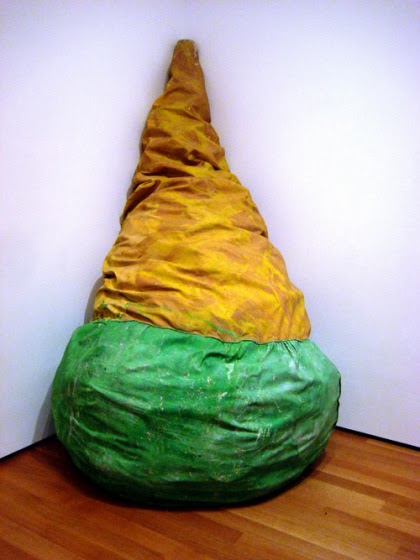Pop Design was
invented in the 1950's and by the word pop they meant popular design. It grew
upon the affluence of the post war society in the 1950s and 60s. It started in
the USA but also grew in England. People were bored with buildings and couldn’t
be bothered to have more straight boring stuff/objects. The Independent group
was formed in London 1952 and its members were; Richard Hamilton - an artist,
Eduardo Paolozzi - a sculptor, Reyner Banham - an art critic and architects
Peter and Alison Smithson, they were the first to explore and celebrate this
movement in America.
In the 1960s
‘low art’ such as advertising, packaging, comics and television were inspiring
artists such as Andy Warhol, Roy Litchtenstein and Claes Oldenburg. Pop design
also began to show in design objects of everyday use. They came up with the
saying “use it today sling it tomorrow”. They didn’t want to follow traditional
norms and behavior they wanted something new unique and totally different.
Designers mixed different eras with each other in design, it was a youth based design
– rock peace and love.
Before pop
design in the 1960s functionalism and good design were popular in Germany and Italy
which then produced Bel (beautiful) design. Development of artificial materials
such as polypropylene gave designers the possibility to experiment with design
and colours. This is how plastics became very popular in design and it aimed at
the youth market which was cheap, fun but without doubt poor quality.
Some designers
were inspired by hippies, pop music, flower power and their own culture such as
foods in diners.
Designs which
were handmade and good such as Marcel Breuer’s and etc. were all looked at as
inhuman, cold and outdated. Colour and ‘ephemerality’ were the new aspects of
design. Pop design drew from many sources such as; art nouveau, art deco,
futurism, surrealism, Op Art – blocks of colour Bridget Riley, eastern mysticism,
kitsch and space age.
‘Less is more’ was no more something they
believed in they did the total opposite which then led to Radical design. Designs
were popular, transient, expendable, low-cost, mass produced, young, witty,
sexy, gimmicky and glamorous. Designers also designed dresses out of paper which
was called ‘throwaway fashion’, which truly began in the 20th
century in Germany but then the idea was brought back to life in the 60s. In
the hopeful, optimistic 60s, paper was the clothing "textile" of the
future. At a time more and more goods were becoming "disposable"
(plates, cups, cutlery, plastics in packaging, tissues, etc.), disposable
clothing seemed like the next big thing.
20s:
60s:
Till this day
we still use things which were invented/designed during the pop design movement
we still have Tupperware and it still is something most of us will find in our
kitchen cupboards and we also are still inspired by Andy Warhol's work as you
can see below.
Warhol's work:
Screenshots I took from a music video which reminded me of his work:

Wine packaging inspired by Warhol:
Beginning of Tupperware to today's Tupperware, more variety of shapes and designs:
idealog. 2010. the die line. [ONLINE] Available at: http://www.idealog.co.nz/blog/2010/07/website-review-dieline. [Accessed 27 December 13].
v&a. 2012. paper dresses. [ONLINE] Available at: http://www.vam.ac.uk/users/node/6419. [Accessed 27 December 13].
mental_floss. 2009. Disposable Suits and Paper Underpants. [ONLINE] Available at: http://mentalfloss.com/article/21361/disposable-suits-and-paper-underpants. [Accessed 27 December 13].
creative glossary. 2011. pop art. [ONLINE] Available at: http://www.creativeglossary.com/art-stylesmovements/pop-art.html. [Accessed 27 December 13].
Fiell, C & P F, 1999. design of the 20th century. 2nd ed. china: ISBN.
Thames & Hudson, T&H, 2004. design since 1900. 2nd ed. singapore: C.C Graphics.






.jpg)






.jpg)

No comments:
Post a Comment